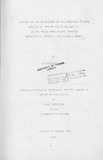Studies on the efficiency of two breeding methods applied to improve yield and quality in two maize populations carrying Brachytic-2, Opaque-2 and Sugary-2 genes
Abstract
A study was conducted on normal KCR and
KCE and their modified mutant populations carrying
brachytic-2, opaque-2 and sugary-2 genes. The
objective was to study the effect of three mutant
genes on yield and protein characters, the eff'_ciency
of two recurrent selection methods (reciprocalrecurrent
selection and Sl testing methods) and an
attempt to improve grain yield, the appearance and
the texture of opaque grains.
After formation of the two triple mutant
populations of KCB and KCE, they were improved using
the two methods separately through one cycle. The
improved populations, their hybrids and previously
converted ~opulations together with four commercial
checks making a total of ?5 entries were evaluated
in 5 x 5 triple lattice designs at four locations.
Results showed that the brac~ytic-2 gene ~ay
or may not affect grain yield, but cefinitely reduced
plant and ear height; it improved lodging resistance
and kept the leaf number constant. It failed to
improve the crop index. The opaque-2 gene improved
n~tritional value but lowered the grain yield; it
made grains much more susceptible to pests and diseases.
Modified grains with varying frequencies rectif~ed
some of the opaque defects. Double mutant population
had better yields, and quality characters; this
was probably due to the favourable epistatic
interactions between the tw6 genes. However, at
the triple mutant level tremendous improvement was
realised.
The relationships between yield and quality
traits were negative. KCE population made faster
genetic gains than KCB. The reciprocal recurrent
selection was much more efficient than Sl testing.
Introgression of genes from KCB population into KCE
and vice versa, that took. place at the time of
formation affected their response to heterosis un+avoureb Iv.
However, after one cycle of selectiol in both methods
the populations responded positively.
Breeding programmes for the release of open
pollinated varieties may have a choice between Sl
testing and reciprocal recurrent ~el8ction methods,
depending on the skill of labour and available
resources. However, in view of a programme for hybrid
production, reciprocal recurrent selection is the
most appropriate.
It wou~J be difficult to encourage the production
of high protein quality maize if it yielded less than
normal maize. In this study it was clearly indicated
that the yield performance of triple mutant hybrids
was equal to the best commercial hybrid grown in Kenya
and as good as their normal counterparts. ThEre is
scope for further improvement in triple mutan£
populations and their hybrids using any of tre
recurrent selection procedures. The role of "genetic
modifiers needs to be studied further particularly .
their inheritance.
Citation
Ogola, E. O(1991). Studies on the efficiency of two breeding methods applied to improve yield and quality in two maize populations carrying Brachytic-2, Opaque-2 and Sugary-2 genesSponsorhip
University of NairobiDescription
Phd Thesis

